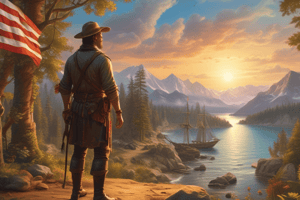Podcast
Questions and Answers
What served as the hearth of the Industrial Revolution in Europe?
What served as the hearth of the Industrial Revolution in Europe?
- The Rhine River Delta
- The Central Uplands
- The Alps
- The North European Plain (correct)
What geographical feature divides the Northwest Highlands and the Central Uplands?
What geographical feature divides the Northwest Highlands and the Central Uplands?
The North European Plain
The North European Plain has significant areas of rolling hills and plateaus.
The North European Plain has significant areas of rolling hills and plateaus.
False (B)
Which of the following describes the physical advantages of the North European Plain?
Which of the following describes the physical advantages of the North European Plain?
The megalopolis extends from London to Zurich.
The megalopolis extends from London to Zurich.
What is one major consequence of urbanization and industrialization in the North European Plain?
What is one major consequence of urbanization and industrialization in the North European Plain?
The region known as the Mittelland is located in _____ between the Central Uplands and Southern Mountain Region.
The region known as the Mittelland is located in _____ between the Central Uplands and Southern Mountain Region.
What natural resource is found in the Northwest Highland region?
What natural resource is found in the Northwest Highland region?
Match the following notable lowlands to their descriptions:
Match the following notable lowlands to their descriptions:
Study Notes
The North European Plain & Lowlands
- Intensive agriculture flourished in the North European Plain due to flat land, fertile soils, abundant fresh water, and a moderate climate.
- This region was crucial to the Industrial Revolution and forms the basis of Europe's Megalopolis.
- Notable for significant human occupation and dense population.
Landforms & Location
- Connects the Northwest Highlands in the north with the Central Uplands and plateaus to the south.
- Extends in a crescent shape from the Pyrenees Mountains through France, England, the Benelux region, Denmark, northern Germany, Poland, Sweden, Finland, the Baltic States, Ukraine, Romania, Moldova, and Bulgaria.
- Characterized as the largest continuous flat area in Europe, interspersed with hills, plateaus, and uplands.
- Major European rivers traverse the region, complemented by extensive canals.
- Certain areas (Denmark, North Germany, North Poland, Finland) face agricultural challenges due to poor drainage and infertile soils.
- The Rhine River delta separates unglaciated lowlands to the south from glaciated plains to the north, with intensive agriculture found south of the Rhine.
- Major European ports located in coastal regions; susceptible to seasonal flooding from Atlantic storms.
Physical Advantages of the North European Plain
- Non-glaciated regions are well-suited for agriculture, urbanization, and industrialization.
- Benefits from flat landscapes and rich loess soils that enhance agricultural productivity.
- A moderate climate supports diverse activities.
- Rivers supply fresh water and hydroelectric power locations.
- Navigable rivers and canals facilitate transportation.
- Accessible coastlines and rich natural resources (coal, oil, natural gas, iron ore, potash) contribute to economic activities.
Population
- Fertile soils and natural transportation routes favor settlement and development.
- Rich in mineral deposits, particularly coal and iron ore, enhancing the region's population density and economic activities.
Megalopolis
- Defined as interconnected cities united by transportation, communication, and finance.
- Extends from London, Paris, and the Benelux region to Germany's Ruhr region along the Rhine River.
- Secondary megapolis areas include Switzerland's Mittelland and Italy's Po Valley.
- Major cities include London, Paris, Berlin, Frankfurt, Zurich, Hamburg, and Warsaw.
Economic Activities
- Urbanization and industrialization have mostly replaced traditional agriculture.
- Coal resources found in Northwest Highland, England, France, Germany, and Poland support steel industries.
- The region faces pollution challenges; it contains abandoned mines, factories, and contaminated sites.
- Oil and natural gas reserves are located in the North Sea and lowlands of Southern England, the Netherlands, and Northern Germany.
- Modern industries and services contribute significantly to the region's economic sustainability.
Other Notable Lowlands
- Consist mainly of river valleys and coastal areas with high population concentrations.
- Includes regions such as the Mittelland (Swiss Plateau), Alfold (Pannonian or Carpathian Basin), Walachian Plain, Rhone River Valley, and Po River Valley.
Mittelland (The Swiss Plateau)
- Situated between the Central Uplands and Southern Mountains, near Geneva and Vienna.
- A key area for settlement and economic activity in Switzerland.
- Influenced by alpine glaciation, featuring lakes, forests, hills, and numerous settlements.
The Alfold
- Surrounded by Alpine, Carpathian, and Dinaric mountain ranges.
- Central valley of the Danube River, encompassing parts of Austria, Slovakia, Hungary, Romania, Serbia, Croatia, and Bosnia-Herzegovina.
- Experiences flooding and soil salinity challenges in some regions.
The Walachian Plain
- Located near the mouth of the Danube River, adjacent to the Black Sea.
Studying That Suits You
Use AI to generate personalized quizzes and flashcards to suit your learning preferences.
Description
Explore key concepts related to the North European Plain and its significance in agriculture and urban development. These flashcards cover essential landforms, locations, and historical impacts of this vital region in Europe. Test your knowledge and enhance your understanding of this geographic area.




